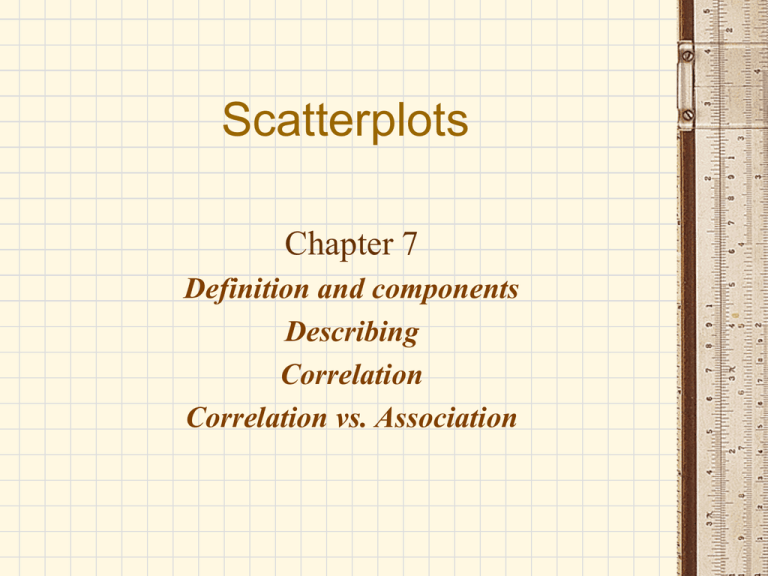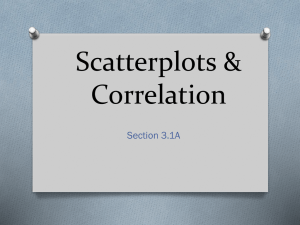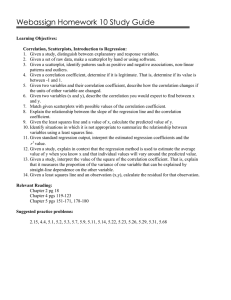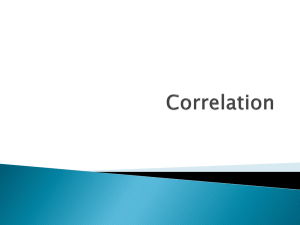Scatterplots Chapter 7 Definition and components Describing
advertisement

Scatterplots Chapter 7 Definition and components Describing Correlation Correlation vs. Association I. Scatterplots • A graph that plots the relationship between two quantitative variables. • Used to see if a relationship exists between the two variables. I. Scatterplots • Explanatory Variable – x- value – Predictor – Input – Independent • Response Variable – Y-value – Output – Dependent II. Creating a Scatterplot • Enter all x-variables in L1, and all y-variables in L2. • Turn on Statplot and go to • Use ZoomStat to obtain graph. • Use Trace to get specific points • Scale and label axes. • I:\Math Department\TI-84Emulator\Wabbitemu. exe Does fast driving waste fuel? Speed (km/h) Fuel used (L/100km) Speed (km/h) Fuel used (L/100km) 10 21.00 90 7.57 20 13.00 100 8.27 30 10.00 110 9.03 40 8.00 120 9.87 50 7.00 130 10.79 60 5.90 140 11.77 70 6.30 150 12.83 80 6.95 • Make scatterplot in calculator. • Transfer information onto your paper, make sure to add labels and scale for x & y-axis. Now try on your own. Either by hand or in the calculator, create a scatterplot of the data on Age at First Word vs. Gesell Score. A score of 100 is considered to be average. III. Describing Scatterplots • Direction – Positive – Negative • Form – – – – Linear Exp. Curve Quadratic curve none III. Describing Scatterplots • Strength – Strong – Weak • Unusual Features – Outliers – Change in form or strength. Example 2 • Describe the following Scatterplots (direction, form, strength, unusual features) Describe the scatterplot you made in the fuel efficiency example. Now try on your own. Now describe the relationship between Age at First Word vs. Gesell Score on your worksheet. IV. Correlation coefficient • Measures the strength of the linear association between two quantitative variables. • In order to use this number, the data must meet the following conditions. – Quantitative Variables Condition – Straight Enough Condition – Outlier Condition (calculate with & without outlier) IV. Correlation Coefficient • To calculate correlation: – Enter data into L1 & L2 – Go to Catalog (2nd ,0) and choose DiagnosticsON. – STAT, CALC, LinReg(ax+b). – The correlation number is the last entry r= • Calculate to correlation coefficient of your speed vs fuel example. • Is it appropriate to use correlation for this example? Why or Why not? IV. Correlation Coefficient • Correlation gives strength and direction. – Closer to -1 indicates perfect Negative linear association. – Closer to +1 indicates perfect Positive linear association. – Closer to 0 indicates NO Linear association. Now try on your own. Calculate the correlation coefficient for the relationship between Age at First Word vs. Gesell Score on your worksheet. Then answer question # 4 on the worksheet. Now try on your own. Calculate the correlation coefficient for the relationship between Age at First Word vs. Gesell Score on your worksheet. Pick up SEC Football Worksheet. This is due at the end of the class. What do you think the correlation coefficients are for the following? IV. Correlation Coefficient • Has no units, based on z-scores • Are unaffected by changes in center or scale. • Can be greatly affected by outliers. V. Correlation vs Association Association Correlation • Indicates that there is a relationship between the two variables (any form). • Measures the strength of a LINEAR association. Examples • Sketch what you think the scatterplot would look like, then describe the association. – – – – – Drug dose vs. degree of pain relief. Calories consumed and weight loss. Hours of sleep and score on a test. Shoe size and grade point average Age of car and money spent on repairs




